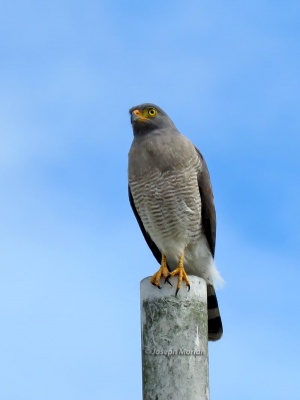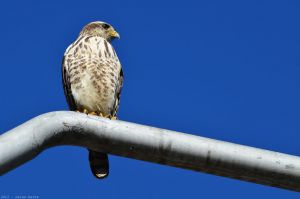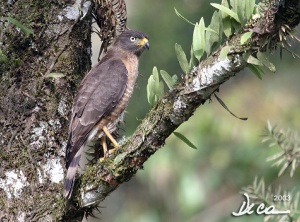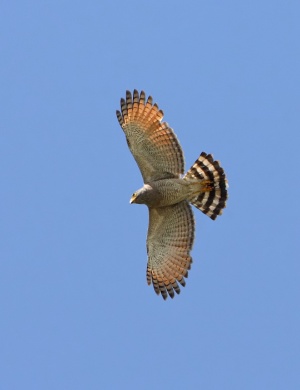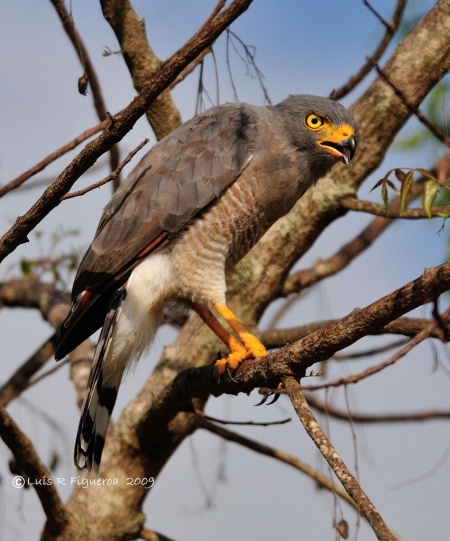
Photo © by Luis R Figueroa
Tucacas, Estado Falcon, Venezuela, 1 September, 2009
- Rupornis magnirostris
Buteo magnirostris
Identification
Total length 32-44 cm (12½-17½ in). Southern subspecies largest. Sexes alike, but female average larger than male.
Overall plumage very variable depending on subspecies, but all with barring to underparts, a dark-banded tail, barred secondaries and primaries with a rufescent patch on the latter (often distinctive in flight), yellowish eyes and orange-yellow cere and legs.
Juveniles generally have browner upperparts (often appears faintly light-scaled), a more streaky chest (less uniform than in adults of most subspecies), a whitish eye-brow and a little/no rufescent patch in the primaries. Juveniles initially have brown eyes, but this rapidly change to yellow as in the adults.
Generally easily recognized by the yellow eyes, the rufesent patch in the primaries and the pattern to the underparts.
Variations
Very roughly, the races can be divided into four groups (but the actual variation is more clinal):
- Mexico and northern Central America: Upperparts and head brown to grey-brown. Tail barred black and grey. Chest brownish or greyish (often streaky) and remaining underparts barred rufescent and white.
- Southern Central America and northern South America: Upperparts pure grey or greyish tinged brown. Tail banded black and grey (black and whitish from below). Chest grey and remaining underparts barred white and grey to rufescent brown.
- Central and eastern South America: Resemble previous, but upperparts more grey-brown and chest and barring to remaining underparts rufescent brown.
- South-central South America: Resemble previous, but barring to tail often rufescent and head and upperparts dark brown (head may appear almost blackish from a distance).
Similar Species
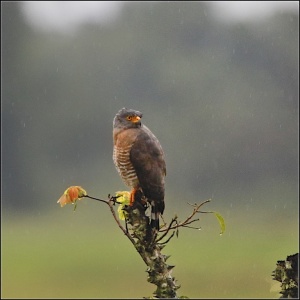
Photo © by Stanley Jones
San Ignacio, near Rioja, San Martín, Peru, 10 January 2017
Grey individuals from northern South America are commonly confused with various forest-falcons (notably the Barred, the Lined and the Plumbeous) or the Grey-lined Hawk.
Distribution
Found from Mexico, south through most of Central America, to South America as far south as north-western Peru on the Pacific slope and central Argentina east of the Andes. Absent from the higher parts of the Andes and most of the Pacific slope of Peru (where too dry; see habitat). There are a number of records from Texas, USA.
Typically common, and in most its range the single most commonly observed species of raptor (perhaps except for certain vultures and caracaras).
Taxonomy
Rupornis vs. Buteo
Molecular evidence by Reising et al. (2003) presented evidence for Buteo being polyphyletic in its current treatment. According to the data, Buteo could retain its monophyly if the Roadside Hawk was placed in the monotypic genus Rupornis and the White-rumped Hawk was placed in the monotypic genus Percnohierax. Alternatively, if these two species stayed in Buteo, genera Parabuteo and Geranoaetus would need to be placed in Buteo to avoid paraphyly[2]. Most authorities now place Roadside Hawk in the genus Rupornis.
Subspecies
Many subspecies of the Roadside Hawk have been described, some of which typically are considered invalid. Twelve subspecies are recognised by Clements[1]:
- R. m. griseocauda: Mexico to north-western Costa Rica and western Panama
- R. m. conspectus: South-eastern Mexico (Tabasco and Yucatán Peninsula) to northern Belize
- R. m. sinushonduri: Bonacca and Roatán islands (Honduras)
- R. m. gracilis: Cozumel and Holbox islands (off Yucatán Peninsula)
- R. m. petulans: South-western Costa Rica and western Panama and adjacent islands
- R. m. alius: Pearl Islands (San José and San Miguel) in Gulf of Panama
- R. m. magnirostris : Colombia and western Ecuador to the Guianas and Amazonian Brazil
- R. m. occiduus: Western Amazonian Brazil, eastern Peru and northern Bolivia
- R. m. nattereri: North-eastern Brazil (south to Bahia)
- R. m. saturatus: South-western Brazil to Paraguay, Bolivia and western Argentina
- R. m. pucherani: Uruguay and north-eastern Argentina (south to Buenos Aires Province)
- R. m. magniplumis: Southern Brazil to north-eastern Argentina (Misiones) and adjacent Paraguay
Habitat
Virtually any habitat with some trees. Avoids the interior of dense humid forest and deserts, but more or less every habitat in between is utilized by this species. Occurs up to an altitude of 2500 m (8200 ft), but rare above 1500 m (4900 ft). Benefits from the widespread clearance of humid forest (e.g. the Amazon) within its range.
Behaviour
Most commonly seen singly, but occasionally in pairs or small (family?) groups. Generally easily observed and not shy.
Flight
Flight consists of a series of rapid flaps alternated with short glides. Only infrequently soars.
Diet
A true generalist, feeding mainly on insects, small mammals and reptiles, but has also been recorded feeding on small birds and fishes[3]. Mainly hunts from a perch.
Breeding
Breeding is seasonal, but timing varies between regions. Typically 1-2 eggs are laid in a large stick-nest in a tree.
Vocalisation
The most commonly heard vocalization is a loud scream, typically given while perched (but also sometimes in flight).
References
- Clements, J. F., P. C. Rasmussen, T. S. Schulenberg, M. J. Iliff, T. A. Fredericks, J. A. Gerbracht, D. Lepage, A. Spencer, S. M. Billerman, B. L. Sullivan, and C. L. Wood. 2023. The eBird/Clements checklist of Birds of the World: v2023. Downloaded from https://www.birds.cornell.edu/clementschecklist/download/
- SACC Baseline read March 2010
- Birdforum thread with several posts discussing food choice of Roadside Hawk (at least posts 14-20)
- Bierregaard, R.O., Jr, Boesman, P. & Kirwan, G.M. (2019). Roadside Hawk (Rupornis magnirostris). In: del Hoyo, J., Elliott, A., Sargatal, J., Christie, D.A. & de Juana, E. (eds.). Handbook of the Birds of the World Alive. Lynx Edicions, Barcelona. (retrieved from https://www.hbw.com/node/53121 on 27 June 2019).
- Global Raptor Information Network. 2019. Species account: Roadside Hawk Rupornis magnirostris. Downloaded from http://www.globalraptors.org on 27 Jun. 2019
- Roadside Hawk (Rupornis magnirostris), In Neotropical Birds Online (T. S. Schulenberg, Editor). Cornell Lab of Ornithology, Ithaca, NY, USA. retrieved from Neotropical Birds Online: https://neotropical.birds.cornell.edu/Species-Account/nb/species/roahaw
Recommended Citation
- BirdForum Opus contributors. (2025) Roadside Hawk. In: BirdForum, the forum for wild birds and birding. Retrieved 17 May 2025 from https://www.birdforum.net/opus/Roadside_Hawk
External Links
GSearch checked for 2020 platform.1




